Disclaimer, this is a rather long and wordy comparison of details that most people probably dont care aboutat all, so read ahead at your own risk, I hope you dont get bored to death, so there, warned you 
As I wrote in my last blog entry, I was wondering how different gameboy systems compare in terms of audio output, because I have heard in the past that the gameboy color output for example is not as good as the original gameboy output so I made my own tests with a gameboy, a gameboy color, a gameboy advance sp, a gameboy player and a nintendo ds (using the goomba gameboy "emulator" on the ds in gba mode).
In all the following tests, I will go over how it just sounds, how much noise comes out of each output, how it looks in a spectrogram and also provide the actual .flac audio files so you can listen to them yourself. All spectrogram images contain the path from where I dropped the audio files in so you can easily grab those audio files from right here:
https://mega.nz/#F!54xGSY7D!AHHPtY7q3ocuWZR-68KPBg!0t4hDBCD
Everything was recorded from my pc line in at 96khz 16bit, the gameboy player at 30% input volume, everything else at 100% input volume, had to be more for the others because they only have headphone outputs after all.
If you are interested in the music of the smurfs at all, most of it can be found in dmg-cpu-06/battery from the mega link above. That mega link also contains several other recordings including NES ones, maybe I will get back to the NES ones in a future blog entry.
If you look at the spectrograms, take note of the bar on the right, essentially how high up it goes, the louder the sound for that given frequency is, going from red (loudest) to green to blue to black (quietest).
I would recommend listening along to the audio files I write about only if you are really interested in this topic at all just so you have heard all these outputs for yourself, maybe I am not the only one that finds things like this interesting, who knows
First, let me start with the best possible audio you can get in my opinion, the original gameboy. Below is a spectrogram of the smurfs title music:
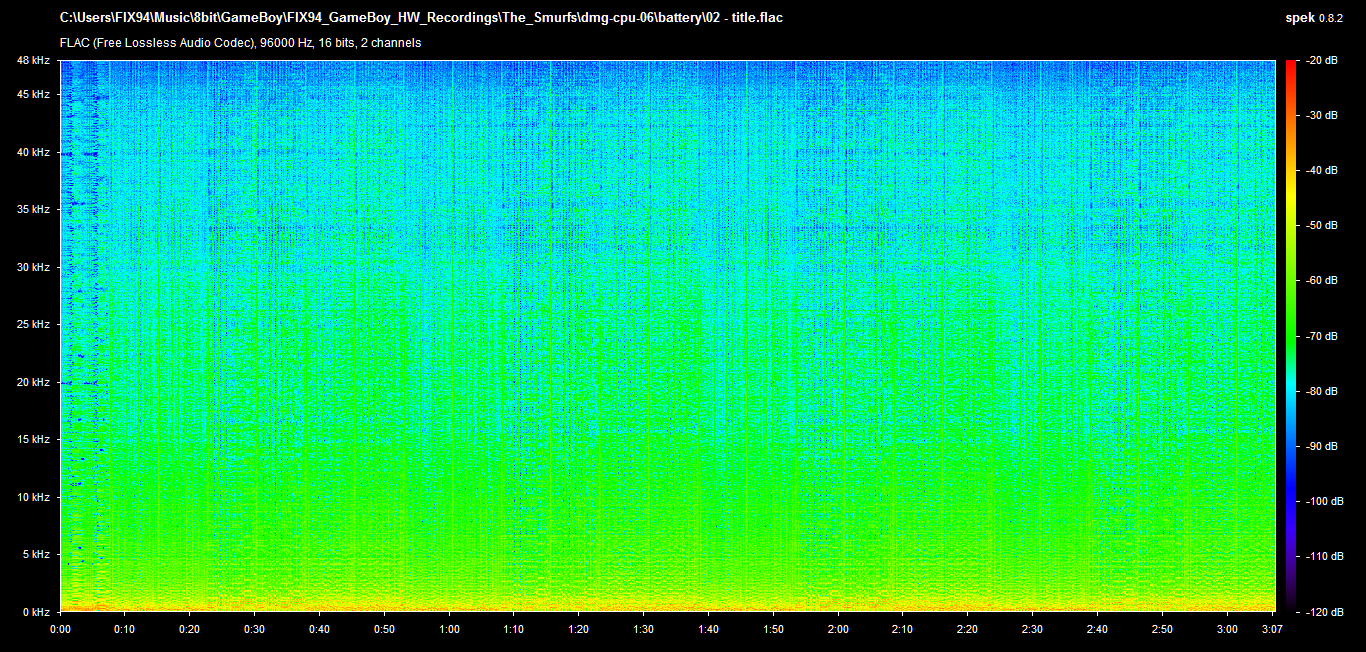 As you can see, there appears to be no hard frequency cutoff, making this the fullest sounding audio you can get. If you wonder how you can see a frequency cutoff you will see this a bit later down from other devices, a lot of the green (audible sound) on higher frequencies will start disappearing.
As you can see, there appears to be no hard frequency cutoff, making this the fullest sounding audio you can get. If you wonder how you can see a frequency cutoff you will see this a bit later down from other devices, a lot of the green (audible sound) on higher frequencies will start disappearing.
Now of course I also wanted to know just how much background noise comes out of the original gameboy when there is silence, so I recorded a bit where it starts out with silence followed by one sound and then by silence again, the spectrogram for that is the following:
 When just powering a gameboy from batteries, there is pretty much no background beeping or anything going on, you can see that the "silent" areas arent exactly very dark colored (quiet) either so it essentially comes across as white noise which is not all that annoying or anything. I also repeated the same test when powering the gameboy using an external power supply instead, resulting in this spectrogram:
When just powering a gameboy from batteries, there is pretty much no background beeping or anything going on, you can see that the "silent" areas arent exactly very dark colored (quiet) either so it essentially comes across as white noise which is not all that annoying or anything. I also repeated the same test when powering the gameboy using an external power supply instead, resulting in this spectrogram:
 At first glance this may look the same but look at the very bottom, do you see that giant green bar? it basically sounds like a low pitched constant hum plus the white noise from before, its not exactly terrible but not great anymore either, at least its better than most other options as you will come to see.
At first glance this may look the same but look at the very bottom, do you see that giant green bar? it basically sounds like a low pitched constant hum plus the white noise from before, its not exactly terrible but not great anymore either, at least its better than most other options as you will come to see.
So next up is the gameboy color, giving us the following spectrogram for the smurfs title music:
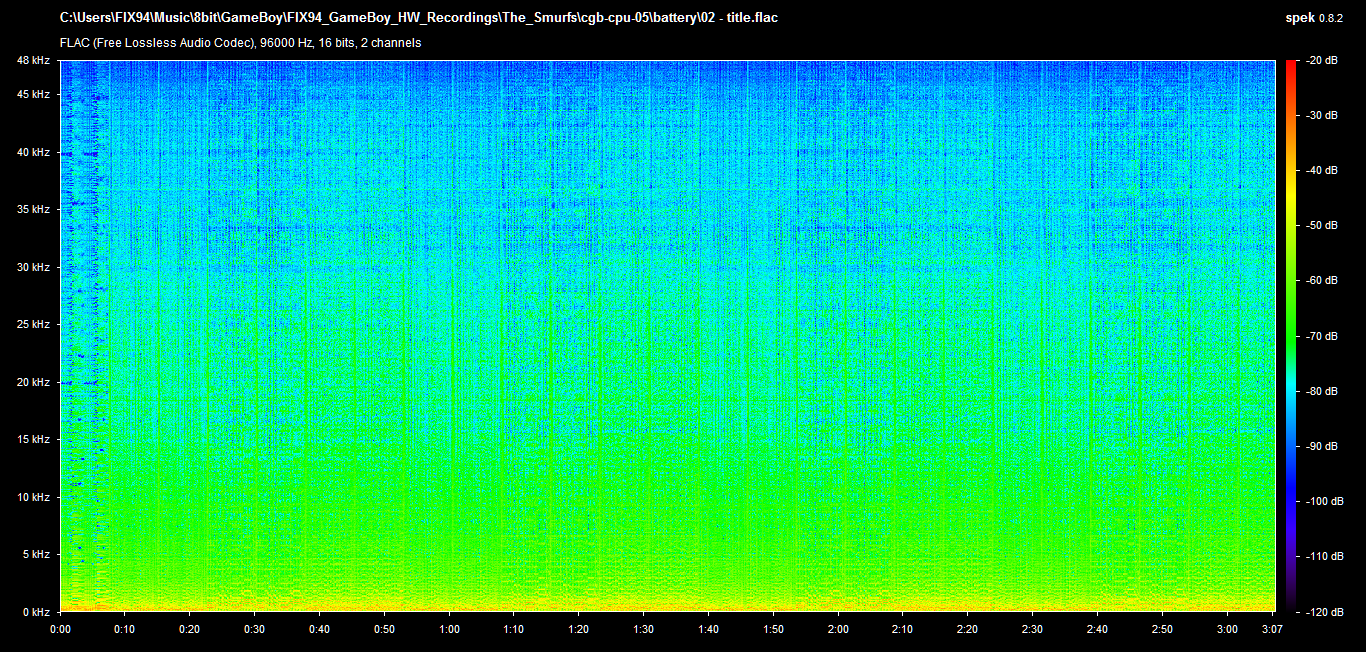 Just like with the original gameboy, the gameboy color also appears to cut of no frequencies, making it sound just as full which is really good. Now to the part I mentioned at the beginning though, the gameboy background noise, here is spectrogram number one:
Just like with the original gameboy, the gameboy color also appears to cut of no frequencies, making it sound just as full which is really good. Now to the part I mentioned at the beginning though, the gameboy background noise, here is spectrogram number one:
 Ouch! Now that is quite a bit worse, there are tons of green (audible) lines accross lots of frequency ranges, making the output not sound all that great compared to the original gameboy anymore. This was from batteries though which is fine, now get ready for the by far worst output of all the ones I tested, powering it using an external power supply:
Ouch! Now that is quite a bit worse, there are tons of green (audible) lines accross lots of frequency ranges, making the output not sound all that great compared to the original gameboy anymore. This was from batteries though which is fine, now get ready for the by far worst output of all the ones I tested, powering it using an external power supply:
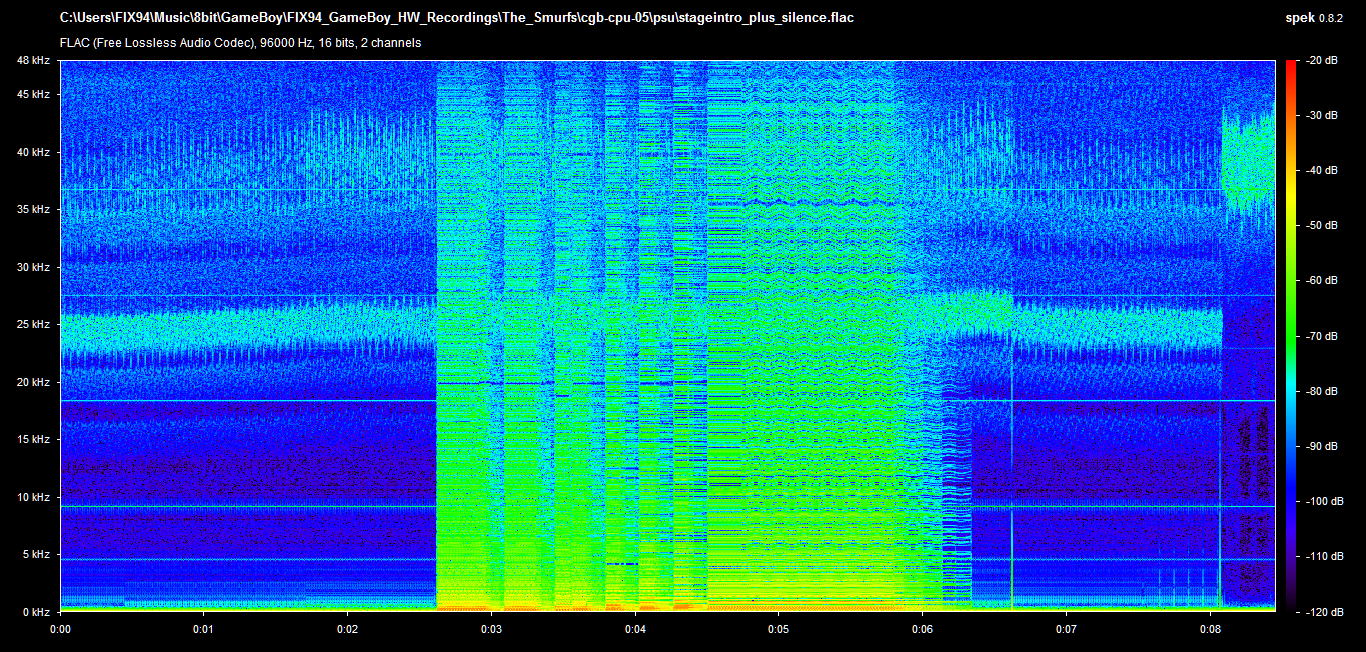 Now THATS what I would call a disaster, I dont think I have to explain exactly why this is so bad if you just look at the previous examples of the exact same sound, this is so much background noise at this point that you can hear it even when music is playing! So if you want to record anything from a gameboy color, I suggest you stay away from an external power supply and just stick with batteries.
Now THATS what I would call a disaster, I dont think I have to explain exactly why this is so bad if you just look at the previous examples of the exact same sound, this is so much background noise at this point that you can hear it even when music is playing! So if you want to record anything from a gameboy color, I suggest you stay away from an external power supply and just stick with batteries.
From now on, you will be able to see frequency cutoff pretty well, starting with the best option you have from the remaining list, the nintendo ds. Here is its spectrogram of the title music:
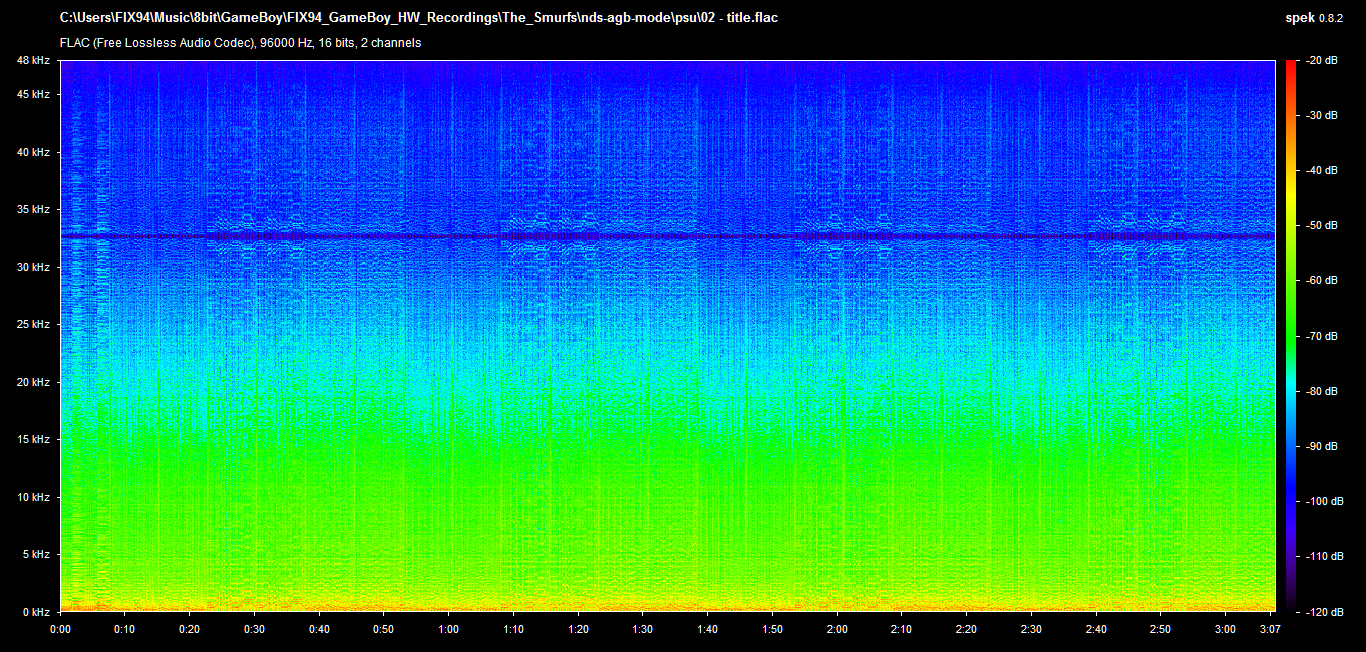 Now I think you can see what is meant by frequency cutoff, in this case starting at 15khz you can see how things slowly get more quiet, honestly this is still sounding pretty alright and does not hurt anything too bad, but it is definitely noticable. Now for the background noise levels:
Now I think you can see what is meant by frequency cutoff, in this case starting at 15khz you can see how things slowly get more quiet, honestly this is still sounding pretty alright and does not hurt anything too bad, but it is definitely noticable. Now for the background noise levels:
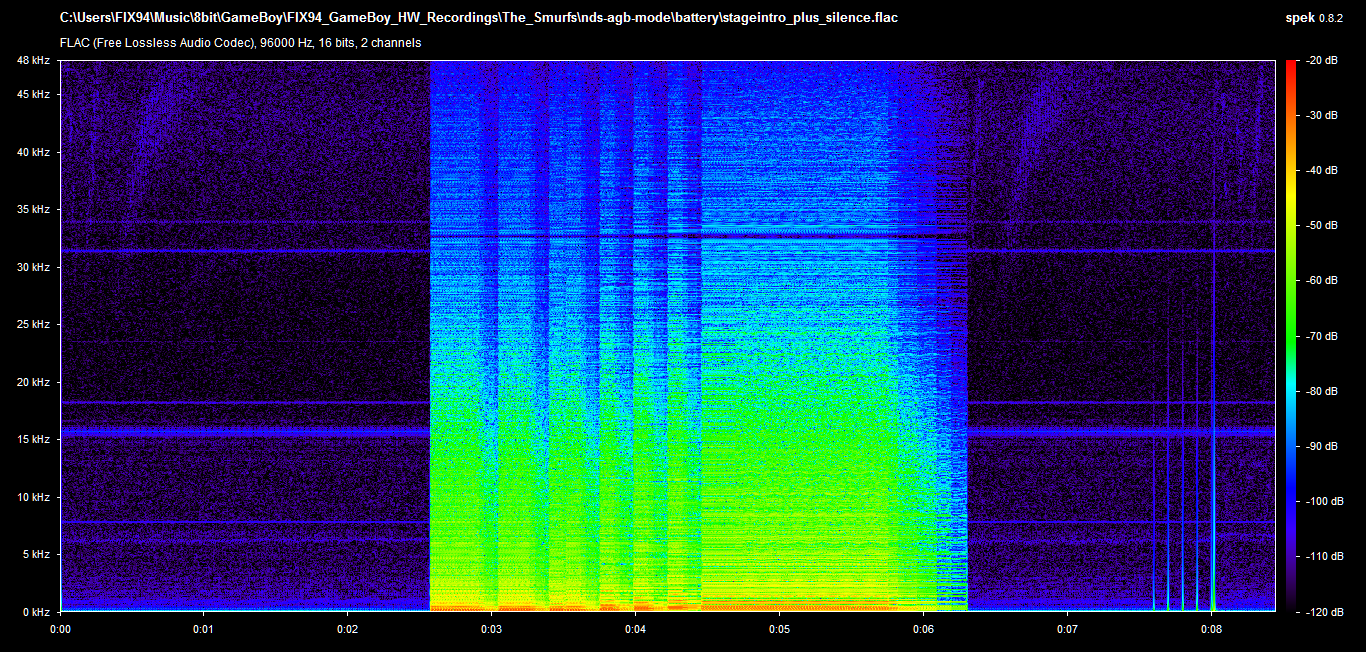 The DS truly has no competition in this field, it is by far the quietest and cleanest you can get, making it the best option after the gameboy and gameboy color for sure.
The DS truly has no competition in this field, it is by far the quietest and cleanest you can get, making it the best option after the gameboy and gameboy color for sure.
Next up is the gameboy advance sp, there is a bit more to this one, recording this one was pretty weird for me as the sp has no headphone jack by default and I dont own one of the adapters for it. So I online looked up the pinout for the port on the back and literally using paper, tape and tin foil I've made my own """adapter""" to wrap around a 3.5mm jack and jam into the sp port on the back, this turned out to work surprisingly well, in fact I also went back and tested this one 2 different DS systems to see if the output being transported by tin foil is any different from the actual headphone out and just look at this spectrogram of the noise test:
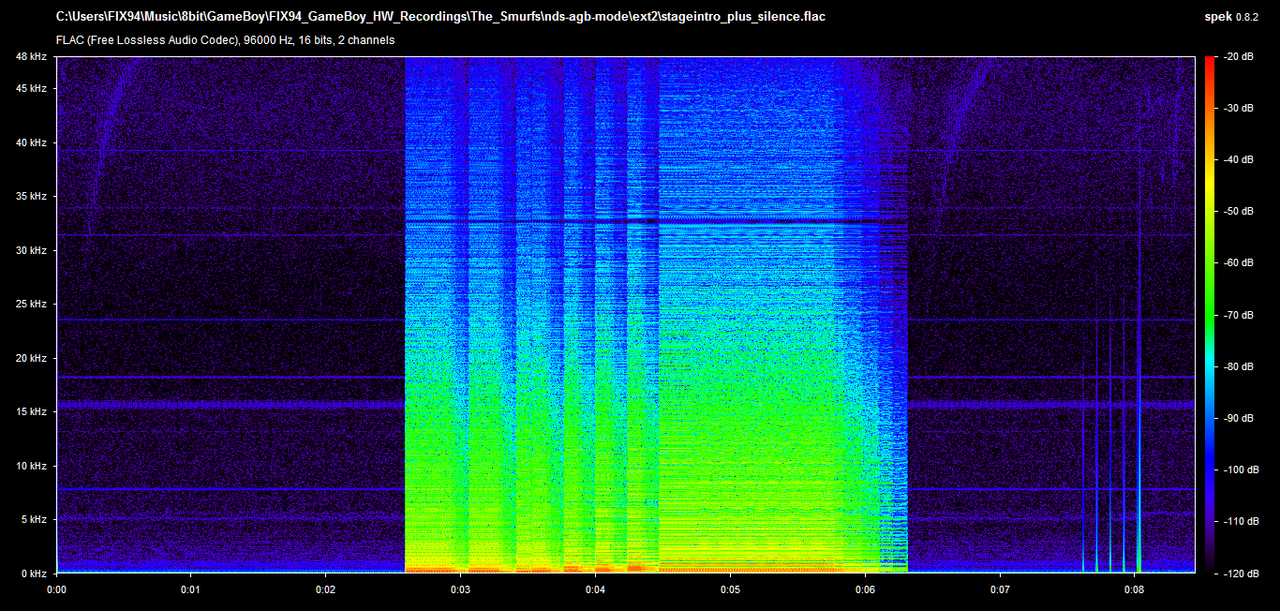 It is what I would call identical to the headphone out! So even though this method is super weird I consider the following gameboy advance sp outputs as correct based on this ds verification. Also I made 3 separate recordings from the gameboy advance sp as well and it also always resulted in the same.
It is what I would call identical to the headphone out! So even though this method is super weird I consider the following gameboy advance sp outputs as correct based on this ds verification. Also I made 3 separate recordings from the gameboy advance sp as well and it also always resulted in the same.
All that out of the way, here is the actual title music spectrogram of the gameboy advance sp:
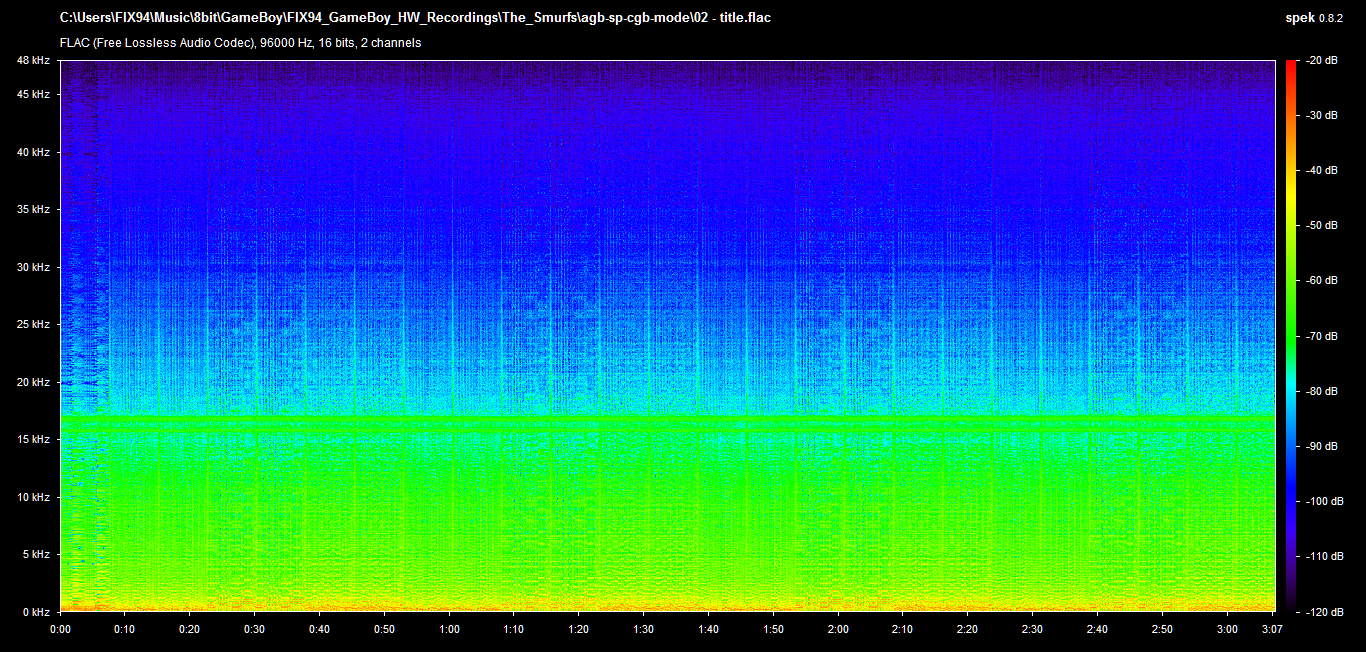 What an early cutoff, seemingly around the 10khz range and then falling off slowly. This just further degrades the audio you hear compared to how we started originally. Also for the noise spectrogram:
What an early cutoff, seemingly around the 10khz range and then falling off slowly. This just further degrades the audio you hear compared to how we started originally. Also for the noise spectrogram:
 It really is not all that great, I cant really describe this any better than saying there is a lot of noise going on, hums, beeps and just everything in between, I guess the word "dirty" describes it best.
It really is not all that great, I cant really describe this any better than saying there is a lot of noise going on, hums, beeps and just everything in between, I guess the word "dirty" describes it best.
Next up is the gameboy player. For this, I tested several different options.
The first one is using the homebrew program gameboy interface, using the standard edition and the "sound=digital" option set when booting it. This is the title music spectrogram:
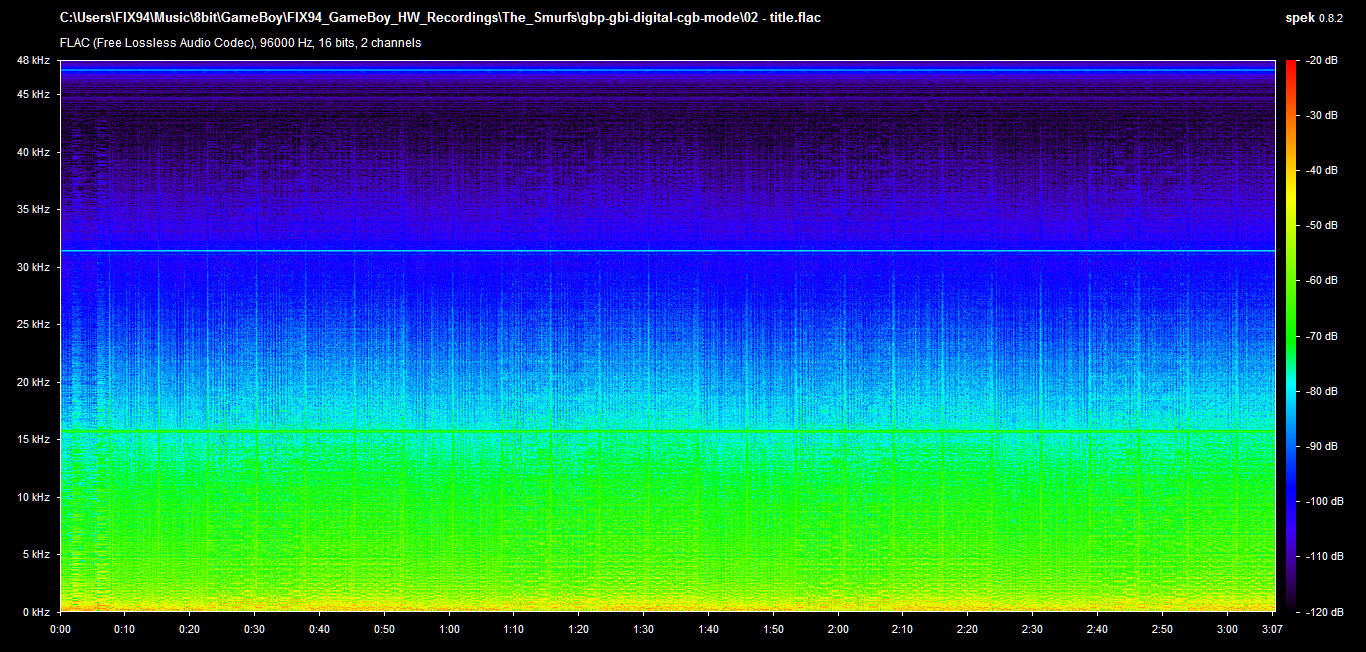 Again just like from the gameboy advance sp we get a cutoff at about 10khz but it then starts dropping a bit quicker, which makes sense considering the gamecube audio output is limited to a sampling rate of 48khz (24khz in frequencies on the spectrogram), so everything above that is not even controllable for the gamecube anyways. The quicker frequency drop is pretty noticeable, making the output more muddy sounding, but it will get so, so much worse...
Again just like from the gameboy advance sp we get a cutoff at about 10khz but it then starts dropping a bit quicker, which makes sense considering the gamecube audio output is limited to a sampling rate of 48khz (24khz in frequencies on the spectrogram), so everything above that is not even controllable for the gamecube anyways. The quicker frequency drop is pretty noticeable, making the output more muddy sounding, but it will get so, so much worse...
Before that though, this is the noise spectrogram:
 You can see it is all very ordered, so there is not much random noise going on, just bit of a low hum really, overall not too bad at all.
You can see it is all very ordered, so there is not much random noise going on, just bit of a low hum really, overall not too bad at all.
Next up is gameboy interface but without that "sound=digital" option set, just a standard option set and standard version, here is that title music spectrogram:
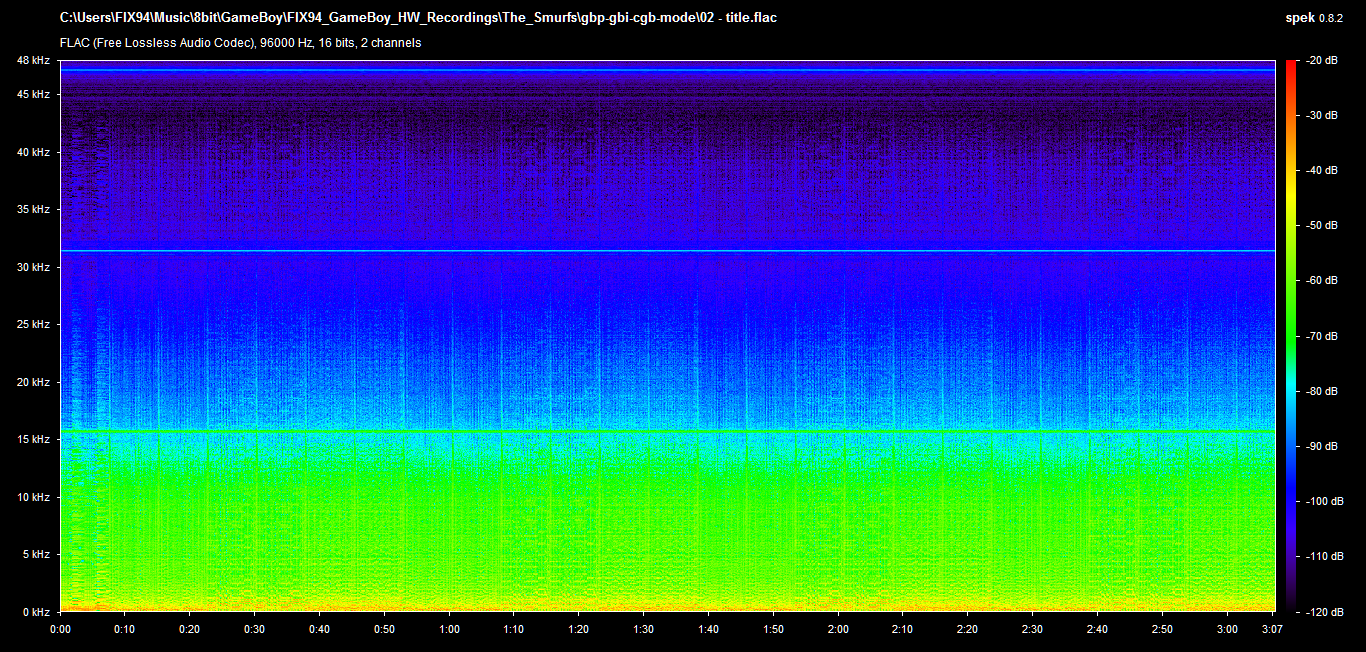 The frequency cutoff is still 10khz, but it drops off even quicker now, so it sounds yet even worse again, not by a lot, but again noticable. No need for a noise spectrogram here, it would just be the same noise image with the sound in the middle having a lower top frequency.
The frequency cutoff is still 10khz, but it drops off even quicker now, so it sounds yet even worse again, not by a lot, but again noticable. No need for a noise spectrogram here, it would just be the same noise image with the sound in the middle having a lower top frequency.
Lastly, at the very bottom stands the official gameboy player startup disc that came with the gameboy player originally, check out this title music spectrogram:
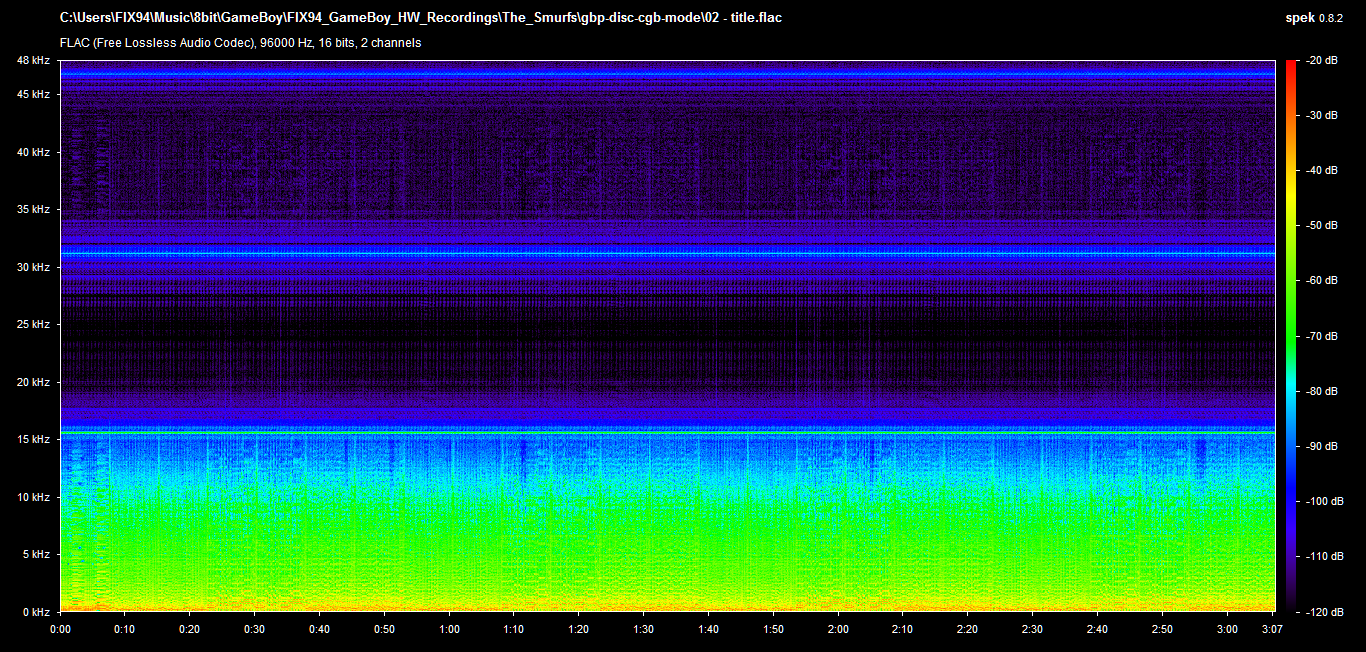 YEP, this image is not a joke, thats what you get from the startup disc. It cuts off hard at 8khz and drops down really quick too, making this sound like something you downloaded via modem back in the day compared to the output of the original gameboy. Just scroll back up and look where we started and now look where we ended up, an output you really dont want to listen to. Again, no noise spectrogram for the same reason as above. So if you have a gameboy player I would very much recommend you use gameboy interface not just because of the better audio but better picture quality and many more options.
YEP, this image is not a joke, thats what you get from the startup disc. It cuts off hard at 8khz and drops down really quick too, making this sound like something you downloaded via modem back in the day compared to the output of the original gameboy. Just scroll back up and look where we started and now look where we ended up, an output you really dont want to listen to. Again, no noise spectrogram for the same reason as above. So if you have a gameboy player I would very much recommend you use gameboy interface not just because of the better audio but better picture quality and many more options.
Right, that is all the testing and comparing I did, what is best for you I dont know, you just have to listen to the original .flac audio files and see for yourself I suppose, so if you ever get into a scenario where you have to choose between different gameboy audio sources you are well prepared I hope. For me personally though if I ever want to record any gameboy audio I will most certainly try and get it from an original gameboy if possible because to me it has the best sounding output and a pretty low noise level. Also I was using gameboy interface with my gameboy player before but now I truly know just how much better it is when it comes to audio when put against the official disc, it is pretty incredible.
That is all for this entry, if you made it this far then that is truly impressive, I do very much hope you at least learned something tiny from reading all of this, I just really wanted to have all my test results written down really, unsure if I should make that in any way public but I guess I now have, thank you for reading this.
As I wrote in my last blog entry, I was wondering how different gameboy systems compare in terms of audio output, because I have heard in the past that the gameboy color output for example is not as good as the original gameboy output so I made my own tests with a gameboy, a gameboy color, a gameboy advance sp, a gameboy player and a nintendo ds (using the goomba gameboy "emulator" on the ds in gba mode).
In all the following tests, I will go over how it just sounds, how much noise comes out of each output, how it looks in a spectrogram and also provide the actual .flac audio files so you can listen to them yourself. All spectrogram images contain the path from where I dropped the audio files in so you can easily grab those audio files from right here:
https://mega.nz/#F!54xGSY7D!AHHPtY7q3ocuWZR-68KPBg!0t4hDBCD
Everything was recorded from my pc line in at 96khz 16bit, the gameboy player at 30% input volume, everything else at 100% input volume, had to be more for the others because they only have headphone outputs after all.
If you are interested in the music of the smurfs at all, most of it can be found in dmg-cpu-06/battery from the mega link above. That mega link also contains several other recordings including NES ones, maybe I will get back to the NES ones in a future blog entry.
If you look at the spectrograms, take note of the bar on the right, essentially how high up it goes, the louder the sound for that given frequency is, going from red (loudest) to green to blue to black (quietest).
I would recommend listening along to the audio files I write about only if you are really interested in this topic at all just so you have heard all these outputs for yourself, maybe I am not the only one that finds things like this interesting, who knows
First, let me start with the best possible audio you can get in my opinion, the original gameboy. Below is a spectrogram of the smurfs title music:

Now of course I also wanted to know just how much background noise comes out of the original gameboy when there is silence, so I recorded a bit where it starts out with silence followed by one sound and then by silence again, the spectrogram for that is the following:


So next up is the gameboy color, giving us the following spectrogram for the smurfs title music:



From now on, you will be able to see frequency cutoff pretty well, starting with the best option you have from the remaining list, the nintendo ds. Here is its spectrogram of the title music:


Next up is the gameboy advance sp, there is a bit more to this one, recording this one was pretty weird for me as the sp has no headphone jack by default and I dont own one of the adapters for it. So I online looked up the pinout for the port on the back and literally using paper, tape and tin foil I've made my own """adapter""" to wrap around a 3.5mm jack and jam into the sp port on the back, this turned out to work surprisingly well, in fact I also went back and tested this one 2 different DS systems to see if the output being transported by tin foil is any different from the actual headphone out and just look at this spectrogram of the noise test:

All that out of the way, here is the actual title music spectrogram of the gameboy advance sp:


Next up is the gameboy player. For this, I tested several different options.
The first one is using the homebrew program gameboy interface, using the standard edition and the "sound=digital" option set when booting it. This is the title music spectrogram:

Before that though, this is the noise spectrogram:

Next up is gameboy interface but without that "sound=digital" option set, just a standard option set and standard version, here is that title music spectrogram:

Lastly, at the very bottom stands the official gameboy player startup disc that came with the gameboy player originally, check out this title music spectrogram:

Right, that is all the testing and comparing I did, what is best for you I dont know, you just have to listen to the original .flac audio files and see for yourself I suppose, so if you ever get into a scenario where you have to choose between different gameboy audio sources you are well prepared I hope. For me personally though if I ever want to record any gameboy audio I will most certainly try and get it from an original gameboy if possible because to me it has the best sounding output and a pretty low noise level. Also I was using gameboy interface with my gameboy player before but now I truly know just how much better it is when it comes to audio when put against the official disc, it is pretty incredible.
That is all for this entry, if you made it this far then that is truly impressive, I do very much hope you at least learned something tiny from reading all of this, I just really wanted to have all my test results written down really, unsure if I should make that in any way public but I guess I now have, thank you for reading this.


